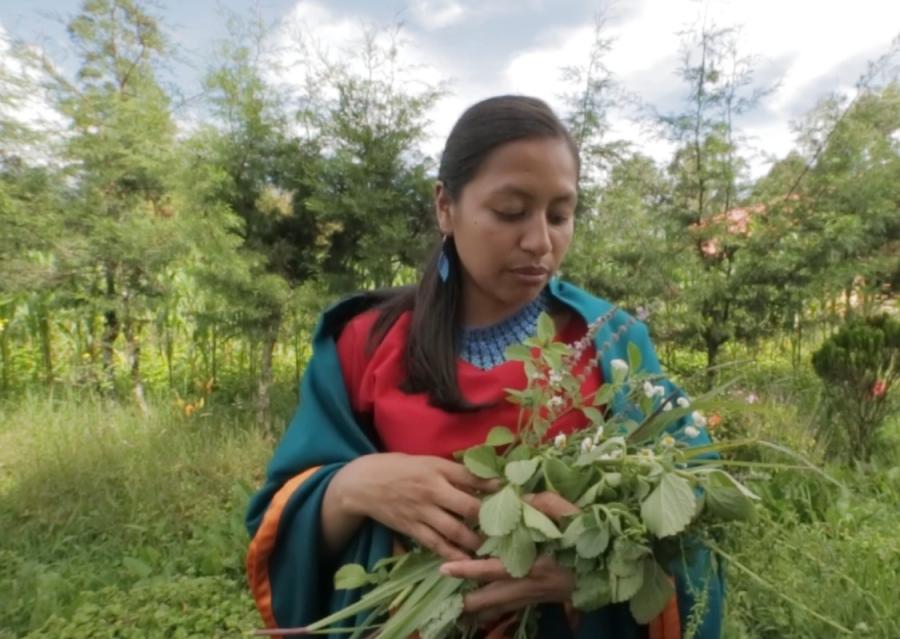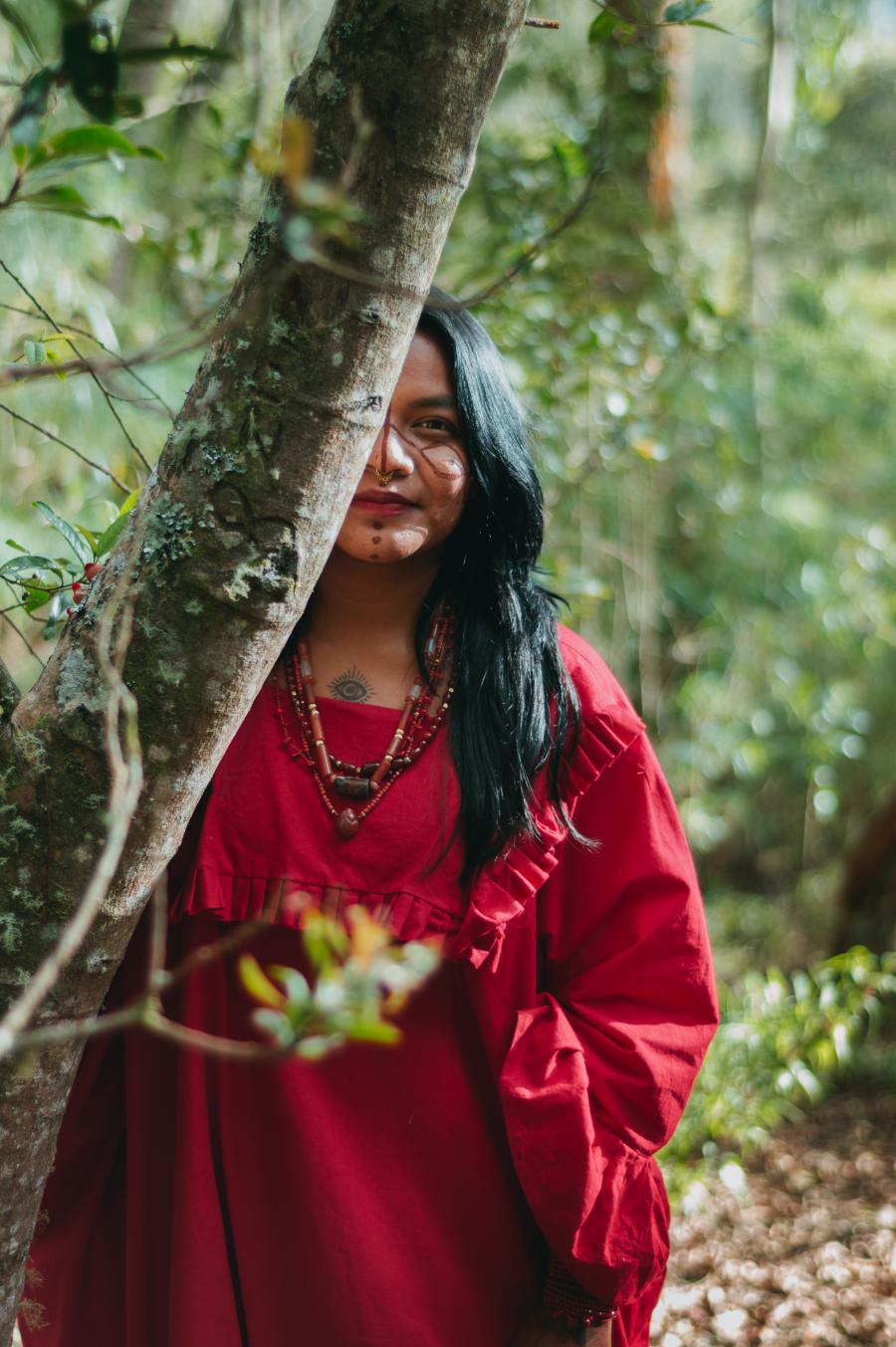
By Reynaldo A. Morales
We left Cali heading for Santander de Quilichao, a traditional Colombian town in the Cauca region, towards the Nasa Peoples’ territory. Our journey with Nasa Indigenous media producer Gustavo Ulcué Campo took us to the Resguardo Canoas, an autonomous collective territory where we visited his family and communal crops, as well as government offices, schools, and assembly spaces. At one point we entered private and sacred spaces of democratic deliberation in which Nasa Peoples caucus across different committees. Indigenous communications emerged from a unique dialogue with State authorities as a national project of understanding Indigenous self-determination and the right to media amidst a climate of extreme militant violence and political instability. With an impressive level of organization, well crafted platforms, and carefully designed stories and messages, Indigenous Colombian communicators are creating and sharing content with their communities and the world, representing a model of Indigenous communication based on complex peace negotiation processes that hold important lessons for the global south.
World Indigenous media was initiated by the Ka Hoku o Ka Pakipika (Star of the Pacific), the first Hawaiian language national newspaper, which circulated for over 150 years. This legacy has been enriched by other publications and newspapers such as the Ka Nupepa Kuokoa (The Independent Newspaper), which operated for 66 years (1861-1927) as the most popular Hawaiian national paper. In the last decade, Indigenous journalism and media have been reconfigured into social and technological platforms communicating across a diversity of knowledge systems and serving as key contributors towards the implementation of sustainable development policies and practices at the local level.

Nasa communicators from Canoas Resguardo, Cauca Norte, Colombia.
In the 1960s and 1970s, UN agencies such as the Food and Agriculture Organization, UNESCO, and UNICEF, along with international aid agencies, designed multimedia approaches to ensure that marginalized populations could access information and education through an integrated Information, Education, and Communication (IEC) platform. In the sphere of public health cooperation among many regions in Africa, Asia, and Latin America, the IEC framework has been the main articulator of community-based participatory mobilization around public campaigns.
As part of that process, popular alternative communication, a concept developed in the 1980s, provided a forum for reporting the participation of Indigenous Peoples in community training and capacity building initiatives. This centralized community-building mechanism was adapted into separate silos within internal Tribal and community-based networks created by different collectives with different communication needs. Some of the initiatives that started within the public radio systems (labeled as “rural radio” and “radio for development”) were conceived specifically for Indigenous populations. As colonized peoples around the world gained their independence, Indigenous Peoples remained designated as internal colonies who were denied the inherent right to exist and develop freely over time and according to their distinctive ways of life.
Gustavo Ulcué, Nasa communicator from Colombia.
Scholars have argued that a real engagement with the aspirations of Indigenous Peoples’ self-determination would involve a much more complex actualization of self-determination than currently exists in the law of decolonization and contemporary understandings of the relationships between self-determining Indigenous communities and States. The 2007 United Nations Declaration on the Rights of Indigenous Peoples underscored, among its tenets on collective rights, the right to self-determination as a principle of the economic, social, and cultural development of Indigenous Peoples. Regarding media specifically, Article 16 clearly establishes the unique and distinct right for Indigenous Peoples to have their own media, and that privately owned media should reflect cultural diversity among Indigenous Peoples. In simple terms, Indigenous Peoples have the right to establish their own media in their own language, and the right to equitable access to all other non-Indigenous media technologies.
Additionally, the Declaration stipulates that nation States shall provide support for national media coverage on sustainable development, climate change, biodiversity conservation, human rights, collective land rights issues, and other issues, duly reflecting Indigenous cultural and social diversity without any form of censure. Nation states are bound without prejudice to ensure that Indigenous Peoples may exercise their full freedom of expression and that such media outlets are not editorially controlled by Tribal governments or governance organizations, in order to adequately reflect Indigenous cultural and economic diversity.
Indigenous Peoples have distinct rights to meaningful representation and challenge of the expansion of corporate capitalism that persists, despite global treaties and conventions, in their titled and demarcated territories, regarding issues of climate change, biodiversity conservation, education, global health, human rights, and sustainable development. The exclusion of Indigenous Peoples from nation States’ visions of modernity and development limits their full participation and meaningful representation in global sustainable development initiatives. Indigenous Peoples’ participation is imperative in the strategic discussion and implementation of global sustainable development treaties, policies, and goals that continue to affect their rights.
Parallels between decolonization and restoration of Indigenous self-governance began in the mid-20th century, challenging mainstream media in settler colonial countries controlled by the dominant ethnic groups. Mainstream media often presented (and continues to refer to) Indigenous Peoples as inferior, enemies of the State and of modernity and progress, and social problems. These forms of discourse and discrimination became the most powerful driving forces of neocolonialism, enabling the exploitation of Indigenous territories and creating untenable conditions for the surviving populations.
Strategic educational communication platforms and investigative science journalism represent vital outlets for Indigenous Peoples to monitor the relationship with their nation States, government institutions, and urban societies. Development of these channels guarantees the survival, revitalization, and continuation of Indigenous Peoples’ cultural, social, and economic governance. Thanks to the transformative impact of digital media and satellite communication, new technologies have been used in the development of Tribal and independent Indigenous media and the advancements of ethnic television that cater to specific interests, cultures, and even languages of immigrant communities in the global north.
Indigenous media networks focus on Indigenous Peoples’ rights, territories, and contributions to sustainable development, which are vital not only for Indigenous Peoples, but for governments, educational and research institutions, and multicultural societies. Meaningful mainstream media representation of Indigenous Peoples is necessary for maintaining a strategic role in global Indigenous issues within the public agenda and facilitating coordination with UN agencies, governments, NGOs, and research institutions as productive partners in global sustainable development initiatives. The issue of meaningful representation is an essential counterpart to the obligations that nation States have ratified through treaties and conventions, all of which have critical implications for the territorial and economic development rights of Indigenous Peoples.
From Colombia to the World
The Public Communication Policy for Indigenous Peoples is the result of a complex five-year process in which Indigenous Peoples from Colombia, through wide local and regional networks, participated in a Permanent Roundtable for Consultation on the urgent dialogue and agreement towards a public policy in Indigenous Communication. Ulcué is an Indigenous Nasa media producer from the Canoas Reserve in the northern part of the Cauca Department and southwestern region of Colombia. He is part of a communication collective called NasaLuuçx and an active member of the National Indigenous Peoples Communication Commission (CONCIP), which serves as a consultation space for Indigenous Peoples’ representatives and delegates from the National Government.
“From this space of consultation in the year 2017, we agreed a public communications policy by and for Indigenous Peoples,” Ulcué says. “This legal framework was active in 2018, composed of two main components: one, the internal communication between Indigenous Peoples and the strengthening of the inherent forms and expressions of social communication. The other was related to media selection and the forms of appropriate communication.” Within the scope of appropriate communications, CONCIP developed two tracks, one related to access and one to the appropriation of radio spaces.
Colombia’s National Plan of Television and Cinematography illuminated components that are reflective of Indigenous audiovisual heritage, connectivity, strengthening of expressions, appropriation of technological means, and communication tools. “In our communication framework we have components such as strengthening of arts and inherent forms of Indigenous cultural production, as well as traditional and ancestral governance processes,” Ulcué says. “All of them are components and lines that make part of a national policy.”
Political will has been a persistent topic and source of uncertainty from Indigenous Peoples’ negotiations with nation States. In Colombia, political dialogue was the main tool to negotiate key safeguards created to guarantee good governance and development of cultural communication processes for Indigenous Peoples. For Campo, that implementation began slowly and unfolded through several stages.“In recent years, however, the Indigenous Colombian media movement advanced in the technical and operational capacity of Indigenous communication collectives that exist across the country. In Colombia, 115 Indigenous Peoples are recognized. Among them, 64 sustain their native or traditional languages,” he says.
Colombia’s Language Law Act was meant to strengthen Indigenous languages in Colombia through effective communication dynamics via their own, and appropriated media. “Recently, in the framework of the new government of President Gustavo Petro, it has been possible to concur with the National Development Plan that puts in action steps for the next four years of government,” Ulcué says. “The government sat for a month with Indigenous Peoples to discuss and agree on the guidelines and requirements that Indigenous Peoples demanded in terms of territorial, cultural, and economic rights.”
The National Communication Commission for Indigenous Peoples followed with an agreement on several lines of implementation, the first being a fortification of public communication policies toward Indigenous Peoples. “The other one is what we call the safeguard plan of Indigenous radio stations and channels,” Ulcué says. “The safeguard plan seeks to create a juridical category that gives economic, legal, and funding sustainability for Indigenous stations that they do not have today.”
Many Indigenous communities struggle with limited internet connectivity. “However, the position of Indigenous Peoples is that their distinctive particularities and needs have to be taken into consideration at the time of making connectivity improvements in their territories, [such as] 4G internet or by any other electromagnetic spectrum that reaches Indigenous territories,” Ulcué says.
Indigenous organizations have agreed to create an Indigenous chapter of the National Plan, or Decade Plan, led by the Ministry of Culture, and are working on a policy to preserve the language, music, and visual canon (including visual graphic and textile art, media, and symbols) of Indigenous Peoples. Ulcué says that CONCIP is building an audiovisual and film laboratory designed by and for Indigenous Peoples. “We hope that all this finally [results in] improved conditions for the collectives and Indigenous Peoples across the different territories in Colombia,” he says, explaining that his efforts have focused heavily on access to “appropriated” communication spaces, such as time slots and programming space in non-Indigenous, government-funded local media.
“I hope that there are economic guarantees for the development and production of content and that there are also guarantees for the protection and safety of the territories and the communicators,” Ulcué suggests, given that many communicators work in territories where there is perpetual armed conflict. “Many times, communication, or the development of communication in Indigenous territories where there is conflict, is very complicated, very complex, and many times it does not provide any guarantees for the communicators. These are all components of the initiatives that are in discussion today around the implementation of this policy framework.”
As we took in the páramos breeze at Canoas Reserve in northern Cauca, looking down the valley where radically different lifestyles and relationships to land exist in the urban center of Cali, I left the Cauca highlands convinced that recognizing Indigenous governance in peace and democracy is a sign that a new Colombia is emerging. Pairing Indigenous Peoples’ self-determination to the right to media means the same for the global south.
-- Reynaldo A. Morales is Assistant Professor at Northwestern University Medill School of Journalism and Media, Faculty Fellow of the Buffett Institute for Global Affairs, and faculty affiliated to the Center for Native American and Indigenous Research.
Top photo: Indigenous Nasa communicators from Canoas Resguardo, Cauca Norte, Colombia.



